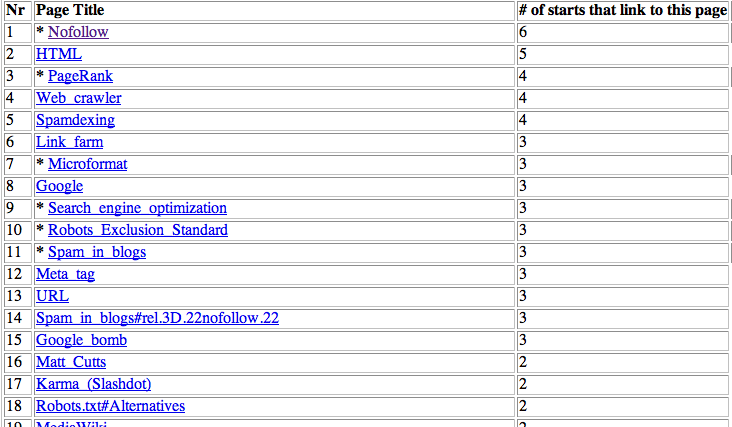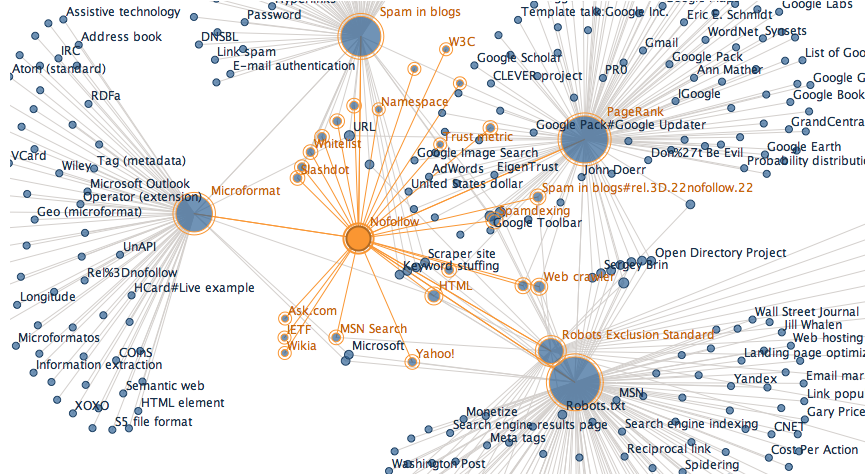You are here: Foswiki>Dmi Web>WikipediaAnalysis (05 Dec 2008, MichaelStevenson)Edit Attach
Analyzing Topic Networks on Wikipedia
Given recent controversies regarding edits to Wikipedia articles by various governmental and commercial organizations, it seems clear that Wikipedia is a space of contestation, of ongoing competition to describe and define the world 'out there'. Wikipedia does not so much produce matters of fact (as many critics have pointed out), but matters of concern. How does one go about studying such a space?Step 1: Mapping Networks of Association on Wikipedia (supported)
The Wikipedia Network Analysis Tool uses link analysis to discover clusters of related Wikipedia articles and ranks them by their prominence within the network. After inputting an article url, the script finds the article's bidirectional links (pages that are linked to by the article and that link back), and scrapes these for all links to Wikipedia articles. The results are combined to produce a ranked 'actant' list, which may also be visualized. Keeping with one of our Digital Methods themes, namely Indexing Issues / Nofollow, here is an example using Wikipedia's Nofollow article. The article, run through the tool, produces a ranked list of associations. The highest ranked for Nofollow are listed below: Ranked Actant List for Nofollow Article on Wikipedia: Under the ranked list, users will find a table that can be exported to visualization services like Many Eyes. Here is the visualization for Nofollow (click here to go to the full, interactive diagram):
Network of Associations | Nofollow | Many Eyes Visualization | 18.08.07:
Under the ranked list, users will find a table that can be exported to visualization services like Many Eyes. Here is the visualization for Nofollow (click here to go to the full, interactive diagram):
Network of Associations | Nofollow | Many Eyes Visualization | 18.08.07: 
Step 2: Mapping Changes in Networks of Association Over Time (partially supported)
A larger aim with the Wikipedia tool is to make changes over time visible. One way of doing this would be to track article edit histories, as with the Wikipedia History Flow project. Another is to follow changes in the article's network over time. In visualizing network histories the emphasis is on context and (in)stability: what associations become fixed, and which ones disappear over time? To track changes in an article's network, repeat step 1 at regular intervals.Step 3: Measuring Network Activity (currently unsupported)
In addition to finding changes in network composition, an analysis of Wikipedia networks should indicate levels of network activity. Referring to an article's version history page, the analyst counts the number of edits made to the article over a set period of time (e.g. the number of edits between each iteration of Step 2). This is repeated for each article in the network. Here, the finding is a measure of the 'invisible work' necessary for maintaining network stability or producing network changes.Tags: , view all tags
| I | Attachment | Action | Size | Date | Who | Comment |
|---|---|---|---|---|---|---|
| |
Picture_4.png | manage | 399 K | 18 Aug 2007 - 21:21 | MichaelStevenson | Network of Associations | Nofollow | Many Eyes Visualization | 18.08.07 |
| |
Picture_5.png | manage | 48 K | 18 Aug 2007 - 21:16 | MichaelStevenson | Ranked Actant List for Nofollow Article on Wikipedia |
Edit | Attach | Print version | History: r8 < r7 < r6 < r5 | Backlinks | View wiki text | Edit wiki text | More topic actions
Topic revision: r8 - 05 Dec 2008, MichaelStevenson
 Copyright © by the contributing authors. All material on this collaboration platform is the property of the contributing authors.
Copyright © by the contributing authors. All material on this collaboration platform is the property of the contributing authors. Ideas, requests, problems regarding Foswiki? Send feedback


